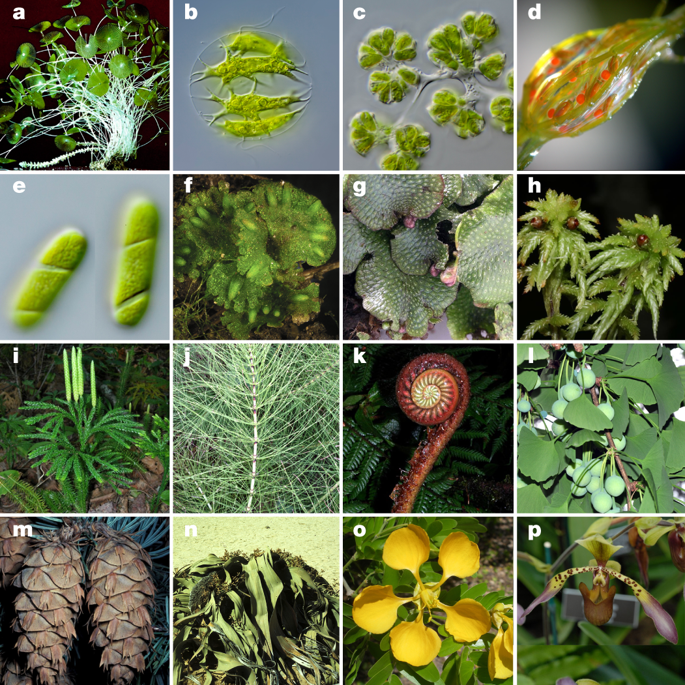Our official English website, www.x-mol.net, welcomes your
feedback! (Note: you will need to create a separate account there.)
One thousand plant transcriptomes and the phylogenomics of green plants
Nature ( IF 50.5 ) Pub Date : 2019-10-23 , DOI: 10.1038/s41586-019-1693-2
Nature ( IF 50.5 ) Pub Date : 2019-10-23 , DOI: 10.1038/s41586-019-1693-2

|
Green plants (Viridiplantae) include around 450,000–500,000 species1,2 of great diversity and have important roles in terrestrial and aquatic ecosystems. Here, as part of the One Thousand Plant Transcriptomes Initiative, we sequenced the vegetative transcriptomes of 1,124 species that span the diversity of plants in a broad sense (Archaeplastida), including green plants (Viridiplantae), glaucophytes (Glaucophyta) and red algae (Rhodophyta). Our analysis provides a robust phylogenomic framework for examining the evolution of green plants. Most inferred species relationships are well supported across multiple species tree and supermatrix analyses, but discordance among plastid and nuclear gene trees at a few important nodes highlights the complexity of plant genome evolution, including polyploidy, periods of rapid speciation, and extinction. Incomplete sorting of ancestral variation, polyploidization and massive expansions of gene families punctuate the evolutionary history of green plants. Notably, we find that large expansions of gene families preceded the origins of green plants, land plants and vascular plants, whereas whole-genome duplications are inferred to have occurred repeatedly throughout the evolution of flowering plants and ferns. The increasing availability of high-quality plant genome sequences and advances in functional genomics are enabling research on genome evolution across the green tree of life.The One Thousand Plant Transcriptomes Initiative provides a robust phylogenomic framework for examining green plant evolution that comprises the transcriptomes and genomes of diverse species of green plants.
中文翻译:

千种植物转录组和绿色植物的系统发育组学
绿色植物 (Viridiplantae) 包括约 450,000–500,000 个物种1,2,具有丰富的多样性,在陆地和水生生态系统中发挥着重要作用。在这里,作为千植物转录组计划的一部分,我们对 1,124 个物种的营养转录组进行了测序,这些物种涵盖了广义植物(Archaeplastida)的多样性,包括绿色植物(Viridiplantae)、灰藻(Glaucophyta)和红藻(Rhodophyta) )。我们的分析为检查绿色植物的进化提供了一个强大的系统发育框架。大多数推断的物种关系在多个物种树和超矩阵分析中得到了很好的支持,但质体和核基因树在几个重要节点上的不一致凸显了植物基因组进化的复杂性,包括多倍体、快速物种形成时期和灭绝。祖先变异的不完整分类、多倍化和基因家族的大规模扩展强调了绿色植物的进化史。值得注意的是,我们发现基因家族的大规模扩展早于绿色植物、陆地植物和维管植物的起源,而全基因组复制被推断在开花植物和蕨类植物的整个进化过程中反复发生。高质量植物基因组序列的不断增加和功能基因组学的进步使得对绿色生命树的基因组进化研究成为可能。千植物转录组计划为研究绿色植物进化提供了一个强大的系统发育框架,包括转录组和基因组不同种类的绿色植物。
更新日期:2019-10-23
中文翻译:

千种植物转录组和绿色植物的系统发育组学
绿色植物 (Viridiplantae) 包括约 450,000–500,000 个物种1,2,具有丰富的多样性,在陆地和水生生态系统中发挥着重要作用。在这里,作为千植物转录组计划的一部分,我们对 1,124 个物种的营养转录组进行了测序,这些物种涵盖了广义植物(Archaeplastida)的多样性,包括绿色植物(Viridiplantae)、灰藻(Glaucophyta)和红藻(Rhodophyta) )。我们的分析为检查绿色植物的进化提供了一个强大的系统发育框架。大多数推断的物种关系在多个物种树和超矩阵分析中得到了很好的支持,但质体和核基因树在几个重要节点上的不一致凸显了植物基因组进化的复杂性,包括多倍体、快速物种形成时期和灭绝。祖先变异的不完整分类、多倍化和基因家族的大规模扩展强调了绿色植物的进化史。值得注意的是,我们发现基因家族的大规模扩展早于绿色植物、陆地植物和维管植物的起源,而全基因组复制被推断在开花植物和蕨类植物的整个进化过程中反复发生。高质量植物基因组序列的不断增加和功能基因组学的进步使得对绿色生命树的基因组进化研究成为可能。千植物转录组计划为研究绿色植物进化提供了一个强大的系统发育框架,包括转录组和基因组不同种类的绿色植物。































 京公网安备 11010802027423号
京公网安备 11010802027423号